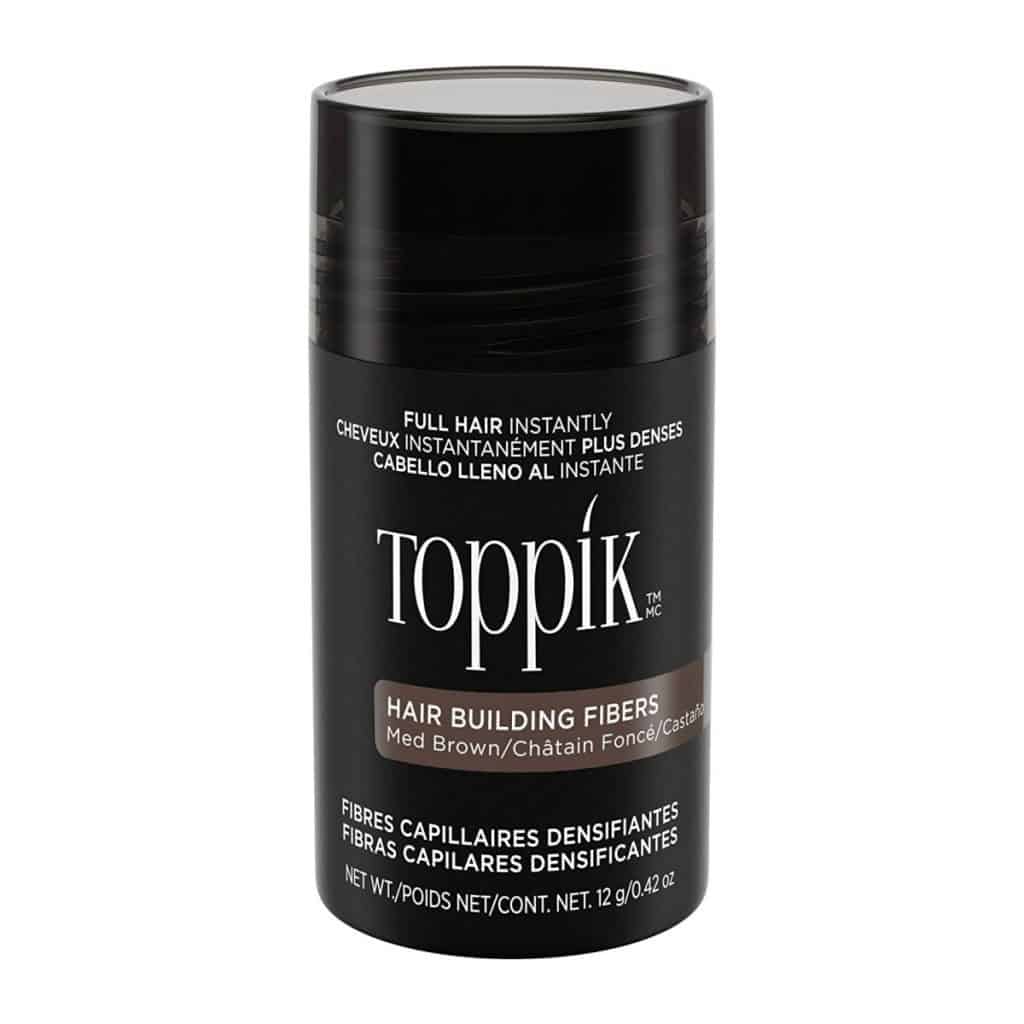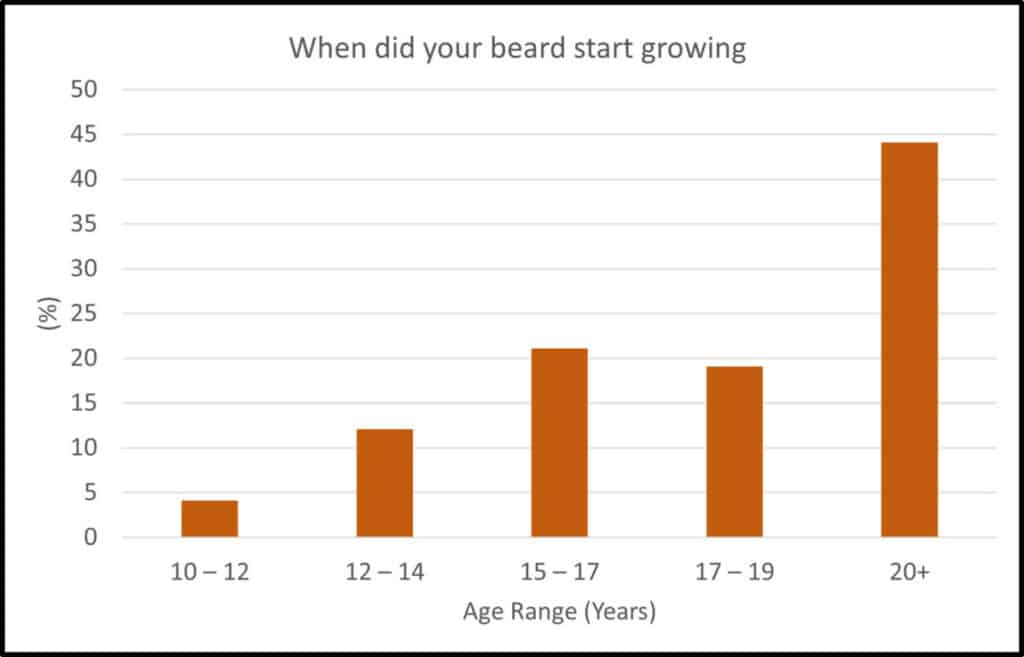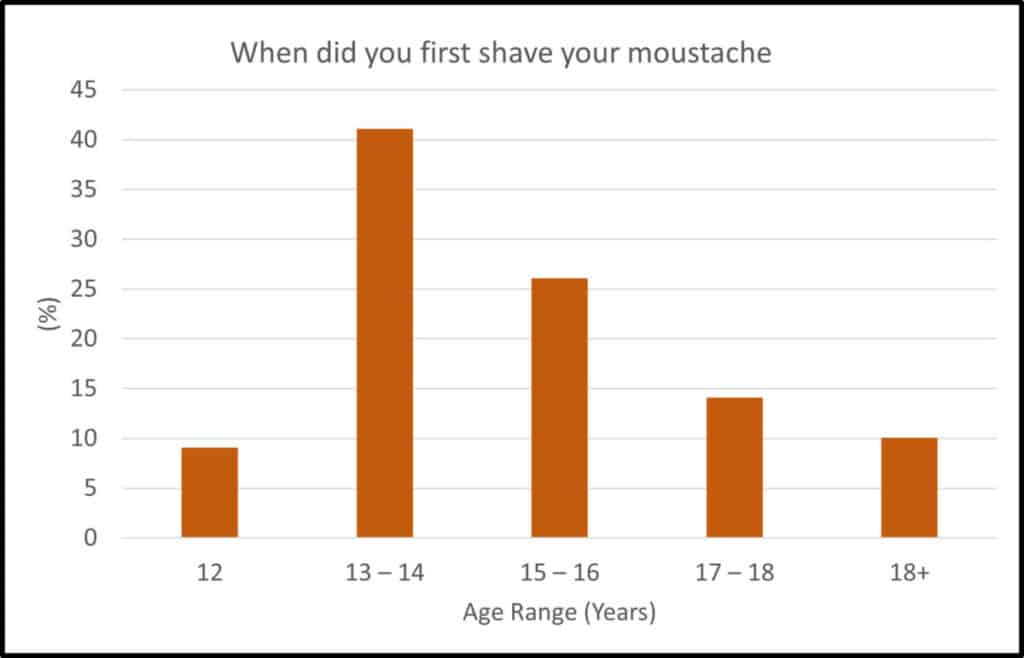As you grow a beard, you become acutely aware of its changes in length. Sometimes, it can feel like watching paint dry in the early days, but what about as you grow older? Does beard growth increase with age? Or do you have to wait longer for your beard to grow as you get older? Here we’ll go through the science and the experiences of men who are growing beards
Beard growth has been shown to increase with age. Puberty causes the onset of beard growth, with most men reporting that their beard grows thicker after 25. A person’s beard darkens and gets thicker as their age increases due to the long-term exposure to testosterone.
Many people believe that they should see a nice thick beard in their teenage years. However, an investigation I performed on my YouTube channel highlights that most people’s beards start growing after 20.
Most teenagers feel like their beard will never come in, and it is often impatience and wrong expectations that lead them to believe they will never be able to grow a beard.
Check out the poll I did on my YouTube channel, which has received over 500 votes from a growing subscriber base that shows:
- only 4% of people started growing a beard by the age of 12,
- 12% of beard growers started growing a beard between the age of 12 and 14,
- 21% of beard growers started growing a beard between the ages of 15 and 17, and
- 19% of beard growers started growing a beard at the age of 17 to 19.
Interestingly, 44% of people only started growing a beard when they had left their teenage years.
On the other end of the spectrum, after thirty men’s testosterone production reduces by about 1 – 2 percent every year, this drop can cause a thinning out of beard hair and reduce the thickness of men’s beards.
All of these effects are hormonal changes in the body and to understand if beard growth increases with age
Article Contents
What causes beards to grow?
When boys enter puberty, the testicles begin producing the hormone testosterone. It is this hormone that is responsible for growing a beard.

In teenage boys going through puberty, facial hair grows and becomes thicker due to the effect of testosterone on the hair follicles. Before that, there was hair present, but it was faint and thin. The secondary hormonal effect is seen quite late in puberty, so many boys think they will never grow a beard.
They have to be a little more patient.
Hair follicles on the face are sensitive to testosterone and what it becomes in the body –dihydrotestosterone (DHT). DHT is made from testosterone by an enzyme called 5-alpha reductase.
One important thing to note is that there is no beard without DHT.
To grow a beard, testosterone, DHT, and the androgen receptors at the base of your beard hairs play a vital role.
The thickness of a beard is determined by the susceptibility of individual hairs to DHT, a testosterone byproduct, rather than the testosterone levels in the body.
As the amount of DHT in the body increases, it has a bigger impact on the surrounding beard hairs, causing them to thicken and darken over time.
The stages of beard growth with age
Don’t have much time? Check out my YouTube video on the topic:
Up until a certain point, beard growth will increase with age. It is the early years of life – specifically around teenage years – where we can expect the hairs on our face to transform into the capability of forming a beard.
I’ve written in detail about the stages and journey of beard growth – click here to read more!
Here are the stages that teenage boys can go through – but remember that each step can vary wildly for each individual depending on genetic and environmental factors.
The moustache develops first for many adolescent males.
I asked over 6,000 people when they first shaved their moustache and found that of the 682 respondents, most people started to shave their moustache at the age of 13 – 14.
Check out the results from my poll here:
Facial hair in males does not always appear in a specific order during puberty and varies among some individuals but may follow this process:
- During puberty, the first facial hair to appear tends to grow at the corners of the upper lip (age 11–15).
- It then spreads to form a moustache over the entire upper lip (age 16–17).
- This is followed by the hair on the upper cheeks and the area under the lower lip (age 16–18).
- It eventually spreads to the sides and lower border of the chin and the rest of the lower face to form a full beard (age 17–21).
- Although this order is commonly seen, it can vary widely, with some facial hair starting from the chin and up towards the sideburns.
As with most human biological processes, this specific order will vary from person to person, depending on genetic heritage and environment – like the ability to live a healthy and active life.
Testosterone (and beards) as we age
Looking at the data above, we can see an important link between testosterone and DHT and the growth of a beard.
We can, therefore, take a look at the amount of testosterone produced in the body as a function of time to determine whether or not beard growth increases with age.
Normal testosterone
The “normal” or healthy testosterone level in the bloodstream varies widely, depending on thyroid function, protein status, and other factors.
According to recent guidelines from the American Urological Association (AUA), a testosterone level of at least 300 nanograms per deciliter (ng/dL) is normal for a man. A man with a testosterone level below 300 ng/dL should be diagnosed with low.
The decrease in testosterone
As men get older, their testosterone levels may decline by about 1 -2 percent per year after age 30.
Although this slight reduction of testosterone doesn’t seem like much on the surface, what this means is that after ten years of a 1-2 % drop every twelve months, a man could find that his production of testosterone is down 20 percent.
The reduction of testosterone can have a tremendous adverse impact on his overall well-being, quality of life, and beard growth and thickness.
Here is a breakdown of the testosterone levels in men at different ages from this source.
| Age Years | Total Testosterone Average Range | Normal Total Testosterone |
| 30 – 40 | 219 – 1009 ng/dL | 600 – 675 ng/dL |
| 40 – 50 | 201 – 993 ng/dL | 500 – 550 ng/dL |
| 50 – 60 | 170 – 918 ng/dL | 400 – 450 ng/dL |
| Over 60 | 156 – 700 ng/dL | 300 – 350 ng/dL |
This reduction in testosterone from the age of 30 will likely cause the beard to reduce in thickness and colour, but your genetics plays a huge part in determining your beard growth.
However, many other factors play an important role in why beards get darker as you age.
Hair growth cycle
Now that we know how important DHT is to growing a beard. Let’s take a look at the steps of hair growth, which is important if we answer the question of the increase of beard growth as people age.
Hair growth goes through three different stages.
- Anagen stage
- Catagen stage
- Telogen stage

The cells in the root of the hair divide fast throughout the anagen phase of the cycle, gradually increasing the length of the hair. The phase of hair might last anywhere from two to six years. Approximately 80 percent to 90 percent of the hairs on your head are in this stage of growth.
The catagen phase is brief interphase between the anagen and catagen phases. This stage is the end of the hair’s growth phase, and no new cells are formed to lengthen it. Hair can be separated from the blood supply for up to three weeks.
After the brief catagen stage, the telogen stage begins. The hair is removed from the skin, and the follicle takes a three-month break. A person’s hair might fall out at a rate of up to 100 per day. After three months, the follicle returns to the anagen phase and generates new hair.
Importantly, all hairs undergo this at a different time, and a thick beard relies on a dense collection of hair follicles in the anagen phase for a long period.
Typically, 15 percent of hair is in the final stages of this cycle.
The rate of beard growth
On average, the growth rate for human hair is about 1.25 centimetres or 0.5 inches per month, or about 15 centimetres or 6 inches per year.
The rate is about 0.35 millimetres daily – think of it like this: you probably won’t get annoyed when you feel your growth is too slow.
The actual “length” of your beard will also depend on if your hair is straight, wavy or curly, as the length will be as long as your beard falls from your face.
The average person can expect to grow anywhere between 12 and 36 inches before their hair stops growing and falls out.
On average, here’s the amount of time it takes to get to each length:
| Month | inches | cm | length |
| 0 | 0 | 0 | Clean-shaven. |
| 0.5 | 0.25 | 0.625 | Stubble to fuzzy stage. |
| 1 | 0.5 | 1.25 | |
| 2 | 1 | 2.5 | You need to have a good shape up here. |
| 3 | 1.5 | 3.75 | |
| 4 | 2 | 5 | |
| 5 | 2.5 | 6.25 | |
| 6 | 3 | 7.5 | Your chin is full and impressive front on. |
| 7 | 3.5 | 8.75 | |
| 8 | 4 | 10 | Looking like a long beard. |
| 9 | 4.5 | 11.25 | |
| 10 | 5 | 12.5 | Substantial beardage. |
For more information, check out my other blog – Will your beard stop growing? Busting the myths!
How to increase your beard growth when you are younger
If you are in the younger stages of life, you may want to enhance your beard growth by using medical interventions or products that can give the appearance of more beard hair than you have.
The proven ways to increase your beard growth when you are younger involve minoxidil.
Minoxidil interventions
Minoxidil was first launched as an oral hypertension treatment in the 1970s. At the same time, doctors detected hair regrowth in balding patients, leading to a topical formulation for treating male pattern baldness in both men and women.
Minoxidil was initially brought to the market in 1986 as a 2% solution, followed by a 5% formulation in 1993. It has remained a popular, topical treatment for a range of hair problems.
How to apply minoxidil
Men who used topical minoxidil grew beards faster than those who used a placebo. The findings were published in the Journal of the Japanese Dermatological Association in 2016. Patients were instructed to dab a 0.5 mL of 3% minoxidil ointment on their chin twice a day.
Because minoxidil has long been used to treat hair loss, it has been demonstrated to provide incredible benefits to patients with various hair-related issues.
Even though topical minoxidil treatment is considered an excellent and safe alternative for various patients, the FDA has yet to improve numerous off-label uses for minoxidil.
You can also increase the efficacy of the topical treatment by using a micro dermal roller which helps the minoxidil penetrate the skin by puncturing the skin using tiny needles on a roller.
Check out the research I provide in my YouTube video below for more information on how to grow a beard.
Products to help boost density
Lastly, you may also want to consider using products to give the appearance of a thicker and fuller beard. Hair fibres are a popular option for people who do not want to go down the medication route.
Hair building fibres can be applied to the surface of the beard with a spray applicator attachment or by shaking the hairs over the surface. Shaking the hair building fibres gives you more coverage over a larger area while using the applicator attachment gives you a more precise application. A puff delivers the fibres of air from the applicator.

Follow these steps to use this beard thickening product:
- Dry and style your hair as usual – hair fibres rely on static to stick to the hair. Therefore, the beard should be as dry as possible to ensure effective static attraction.
- Shake the hair fibres over the region you want to darken or use the applicator to apply them.
- A hairline optimiser is included in some formulations, which can be applied to the beard’s edges for a more natural look.
- Pat the hair gently to spread the hair fibres and prevent clumps from forming.
- Consider using a fibre hold spray to help strengthen the bond between your hair and the fibres that help it grow.
The final word – Does beard growth increase with age?
Your beard growth and age are intimately related. From the moment you go through puberty up until the age of thirty, testosterone increases in your body, which will help your beard grow.
After 30, your testosterone decreases about 1 – 2 percent each year. A reduction of testosterone will impact your beard growing potential. But, it’ll be your genetics and how well you look after your beard that will determine the magnitude of that effect.






